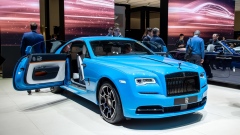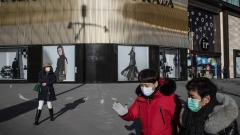Oct 25, 2020
The 2021 Ferrari Roma Is the Most Perfect Ferrari on the Road Today
, Bloomberg News
(Bloomberg) -- Beauty has restorative powers. Just ask visitors to the Metropolitan Museum in New York, to the desert monoliths in Moab, to the new Dries van Noten store in Los Angeles since the start of the novel coronavirus pandemic. Even if objets d’art can’t cure Covid-19, they calm the mind, soothe the soul, inspire the heart.
I am not so cynical as to believe that the same aesthetic properties don’t apply to cars. But I am wise enough to know that automotive providers of such respite are few and far between, especially if they’re new. In my 16-plus-year career I have seen a few gorgeous cars and many that are forgettable; it takes a lot these days to take my breath away.
The Ferrari Roma did. It is the most beautiful new car I’ve seen all year.
Conceived as a return to the stunning and astronomically expensive 250 GT Lusso and other grand touring cars Ferrari produced in the 1950s and 1960s, the $218,670 Roma comes with balanced, monolithic lines that swoop from front to back and a stunning perforated grille that pulls the color and shape of the whole car forward into an elegant arrow. It feels like a deep exhale and release into serenity, while the clamoring of the modern auto market’s tank-sized trucks, reptilian hypercars, and sedans as forgettable as droids fade out of view.
Set to go on sale in spring 2021, the Roma is the kind of irresistible diversion that can bring us all a brief respite from current troubles, even for those who see it only from the outside. It’s arriving just in the nick of time. Car lovers, we need this.
A Civilized Stallion
The Ferrari Roma joins the Ferrari lineup as a brand-new model that offers the same two-plus seat configuration as the open-top Portofino M. (That’s the term Ferrari uses to let us know the car technically has two back seats, but you probably won’t be able to fit in them.)
Many will evoke the dolce vita cliché that describes how the Roma looks and feels. After all, it is meant for the kind of glamorous sun-drenched driving showcased in the Fellini film. Undeniably, it is far more suited to soaking up the sweet life on a daily basis than the 812, 488, SF90 Stradale, and F8 Tribuno Ferraris in all their sinuous glory; this is a true grand tourer with space in the back seat and enough room in the trunk for weekender baggage. As I found during my circuitous test drive from Beverly Hills to Pyramid Lake, Fraser Park, Ojai, Malibu, and back to downtown L.A.—300 miles and more than six hours of driving—its higher clearance height, less ragged engine note, and sophisticated driving properties are much more generous in sating the desires of daily life.
The Roma has a 611-horsepower V8 mid-front-mounded engine, eight-speed paddle-shifting transmission, and rear-wheel drive. Zero to 60 mph takes 3.4 seconds; top speed is 199 mph. As I climbed the hills on the back side of Ojai, I thrilled in steering that was so smooth and delicate around every corner while the turbocharged engine provided instantaneous reactions to my request for more speed. It’s fair to say I upped the aggression of my driving, based on the brakes that took effect so quickly—balanced and smooth—that they instilled a preternatural sense of trust.
On the whole, Roma feels silkier to drive than such siblings as the 710-horsepower F8 Tributo and 788-horsepower 812 Superfast. It offers a more intimate connection between car and driver than those high-echelon Ferraris whose whopping power ratings and track-calibrated engineering give them prowess that remain largely untapped by anyone without years of professional driving experience. In the Roma, I felt I could access and embrace the whole car as I drove, not just dip my toe into the overwhelming ocean of what it can do, lest I lose control altogether.
Beauty as Tonic
I wanted to get those engine specs out of the way early because, yes, Roma’s performance is superb. But the defining elements and best reason to buy the Roma is its jaw-dropping and deeply thoughtful design, inside and out.
The exterior, as I mentioned, has classic fastback lines, a long front, and that uber-cool perforated grille that carries the body’s color forward in a svelte shark nose. These are designs we have not seen in recent modern Ferraris. Many new cars blend together in their sameness; this all feels truly special. Horizontal LED headlights and the small spoiler hidden until the car accelerates maintain the elegance without detracting. They help keep the car’s exterior lines pure. (No manual option exists to deploy said spoiler at a standstill—that would be gauche.)
I’m delighted that Ferrari has made an ingenious key fob to go with Roma, a tiny rectangle of leather and enamel that, unlike the hulking fobs from BMW and Porsche, might even fit into your pocket. It is the first key I’ve seen that matches the level of quality and craftsmanship of the car it unlocks. Ferrari also cleverly made a space in the center console perfectly sized to store the fob once inside the vehicle—an oversight of virtually every other luxury automaker. Often, I find that key fobs awkwardly roll around in cupholders or passenger seats, clanking against the plastic as I round every bend.
The cabin lives up to what the exterior promises. It’s covered in high-end leather and carbon-fiber trim; the seats are oriented so far back it feels (delightfully) as if you’re almost over the rear wheels, with the hood protruding boldly out front. But what I noticed first—and what I remembered most about the interior—is the configuration of the shifter. It’s designed to look like an old metal gated shifter, but instead of using a clutch to operate a true manual transmission, each gate in the “shifter” is a button that you push to engage drive, reverse, and so forth.
There’s also the matter of the start button, now a small, round touchscreen located at the center of the steering wheel. Like the rest of the steering wheel and dashboard—minus the mechanisms to engage wipers, lights, and the toggle switch that controls drive modes—it operates only by touch. Press the round circle indicated by lighting, and the car will start.
Another refreshing innovation: Ferrari has clustered touchscreen controls more often used (volume, for instance) toward the center of the steering wheel and placed less-used controls (vehicle info, maps) on the outer regions in the center console of the car and the dashboard. It’s a common-sense solution that helps drivers like me stay focused, with hands on the wheel and eyes on the road.
Some may contemplate the vertically oriented touchscreen, which sits as if it were slipped into the center of the dashboard, as an afterthought. Others may dislike the double-sized enlargement of the passenger-side screen, which reports driving and performance statistics in real time to your shotgun rider.
Neither bothered me. I found virtually nothing with which to quibble regarding the Ferrari Roma; even the upscale price makes it the most affordable coupe in the Ferrari range. In base form, it even dovetails with the $200,000-plus Porsche 911 Turbos being sold in droves by the Exclusive Manufacturer department out in Stuttgart, Germany.
If I had to choose between the Roma and the astoundingly excellent, if ubiquitous, 992 Turbo S I drove earlier this year—the best car I’d driven until now, and a top contender for the car I’d personally wish to own—I’d give the edge to the Roma. Roma has the exquisite, old-world presence of a true nobildonna. In this age, that’s a reassuring thing, indeed.
©2020 Bloomberg L.P.


